Software-as-a-Service-Anwendungen haben die Art und Weise, wie Unternehmen Technologie bereitstellen, verändert, doch diese Innovation bringt einige komplexe Überwachungsprobleme mit sich. Wenn Ihre Endbenutzer eine Verlangsamung feststellen, Ihr Dashboard aber anzeigt, dass alle Systeme in Ordnung sind, ist dies in der Regel auf blinde Flecken bei der Überwachung zurückzuführen, die bei SaaS-Konfigurationen auftreten.
Herkömmliche Überwachungsstrategien, die sich für die Überwachung von Anwendungen entwickelt haben, die sich in einem kontrollierten Rechenzentrum befinden, bieten keinen Einblick in kritische Fehlerpunkte in SaaS-Bereitstellungspfaden. Mit einer mandantenfähigen Architektur, Abhängigkeiten von Drittanbietern und Internet-Infrastrukturkomponenten erfordern die heutigen Anwendungen Überwachungsstrategien, die den gesamten Servicebereitstellungsstapel umfassen.
In diesem Leitfaden werden die wichtigsten Überwachungstools und -techniken vorgestellt, um eine optimale SaaS-Leistung in den heutigen Umgebungen zu gewährleisten.
Zusammenfassung der wichtigsten Funktionen, die bei SaaS-Überwachungstools zu beachten sind
Anforderungen an die SaaS-Überwachung
SaaS-Anwendungen bringen Herausforderungen für die Überwachung mit sich, die bei herkömmlichen Konfigurationen nicht auftreten. Während herkömmliche Anwendungen in verwalteten Rechenzentren untergebracht sind, werden SaaS-Anwendungen auf einer verteilten Infrastruktur mit vielen möglichen Fehlerpunkten gehostet.
Herausforderungen der Cloud-Infrastruktur
Inhärente Unterschiede führen zu einigen blinden Flecken bei der Überwachung. Herkömmliche Überwachungstools können nicht immer mit der Änderungshäufigkeit einiger Codebasen Schritt halten. Dies kann zu veralteten Metriken oder einer Überwachungseinrichtung führen, die das System nicht vollständig abdeckt. Ein gutes Setup stellt sicher, dass die Skalierung der Ressourcen dynamisch erfolgt und unterschiedliche Metriken im Vergleich zu statischen erfordert. Die Konfiguration sollte auch über infra als Code erfolgen.
Die Mehrmandantenfähigkeit erhöht die Komplexität. Alle oder ausgewählte Gruppen können von Leistungsproblemen betroffen sein. Die Betriebsteams müssen die Mieter kennen, um zwischen systemischen und lokalen Problemen unterscheiden zu können.
Herausforderungen der Architektur
Moderne verteilte Systeme verschärfen diese Probleme. Microservices, die sich über viele Regionen erstrecken, schaffen viele Stellen, an denen Probleme unsichtbar bleiben. Eine Transaktion, die Dutzende von Diensten durchläuft, lässt sich ohne spezielle Tools nicht nachvollziehen.
Herausforderungen durch die Abhängigkeit
Abhängigkeiten von Drittanbietern führen zu einer neuen Ebene der Komplexität. SaaS-Anwendungen müssen mit verschiedenen Diensten von Drittanbietern interagieren, z. B. mit Zahlungsabwicklern, Authentifizierungs- und Speicherdiensten. Wenn etwas ausfällt, ist es kritisch, aber es ist schwer zu sagen, ob das Problem mit Ihrem Code oder einer Drittanbieterabhängigkeit zusammenhängt.
Herausforderungen im Netz
Am wichtigsten ist, dass Ihr Internet Teil der Infrastruktur Ihrer Anwendungen ist. Dieser "Internet-Stack" umfasst Content-Delivery-Netzwerke, DNS-Anbieter, Backbone-Anbieter und die letzte Meile der Konnektivität. Ein Problem an irgendeinem Punkt in der Bereitstellungskette wirkt sich auf die Benutzer aus, unabhängig vom internen Zustand Ihrer Anwendungen.
Die wichtigsten Funktionen des SaaS-Überwachungstools, auf die Sie achten sollten
Eine effiziente SaaS-Überwachung erfordert einen Einblick in diesen gesamten Stack. Teams benötigen proaktive Benachrichtigungen, aktuelle Metriken zur Benutzererfahrung, API-Leistungsüberwachung, Einblicke in die Infrastruktur und End-to-End-Überwachung des Internet-Stacks.
Im Folgenden finden Sie einige Funktionen, die Sie bei der Auswahl eines modernen SaaS-Überwachungstools berücksichtigen sollten.
Synthetische Überwachung
Bei der synthetischen Überwachung werden Skripte von der Software ausgeführt, die Benutzeraktionen aus verschiedenen Regionen imitieren. Anstatt darauf zu warten, von Kunden über Probleme informiert zu werden, können Sie die Leistung und Funktionalität von Anwendungen proaktiv testen.
Obwohl die synthetische Überwachung im Gegensatz zum tatsächlichen Nutzerverkehr keinen Schwankungen bei den Browsereinstellungen oder den Nutzermustern unterworfen ist, lassen sich durch die Durchführung derselben Tests in bestimmten Zeitabständen von verschiedenen geografischen Standorten aus robuste Grunddaten ermitteln.
Die synthetische Überwachung ist in mehreren wichtigen Situationen nützlich.
- Testet geschäftskritische Aktivitäten wie Anmeldungen und Abrechnungen in Echtzeit.
- Sie erhalten objektive SLA-Messungen, die nicht mit echten Benutzerdaten repliziert werden können.
- Unterstützt das Benchmarking von Wettbewerbern und sorgt für die Integration von Dritten.
Ihr wichtigster Wert besteht darin, dass sie die Sichtbarkeit außerhalb der Geschäftszeiten aufrechterhält, wenn der tatsächliche Benutzerverkehr nachlässt, die Verfügbarkeit aber weiterhin wichtig ist. Catchpoint bietet einen großartigen Leitfaden zur synthetischen Überwachung.
Echte Benutzerüberwachung
Ihr SaaS-Überwachungstool sollte sowohl synthetische als auch reale Benutzerüberwachungsfunktionen bieten. Während die synthetische Überwachung periodische Baselines erstellt, verfolgt die reale Benutzerüberwachung (RUM) die tatsächlichen Benutzeraktionen. Ein browserbasiertes RUM sammelt tatsächliche Leistungsmetriken von echten Nutzern und misst die Seitenladezeit, Netzwerkanfragen und das Front-End-Rendering-Timing.

Aufgrund der unregelmäßigen Konnektivität und der unterschiedlichen Gerätefunktionen stellen mobile Anwendungen besondere Herausforderungen an die Überwachung. Mobile RUM löst diese mit einer leichtgewichtigen SDK-Integration. Es misst die Leistung unter verschiedenen Netzwerkbedingungen und überwacht anwendungsspezifische Daten, wie z. B. die Startzeit und Bildschirmübergänge.
Catchpoint Mobile RUM mit OpenTelemetry-Integration bietet tiefe Einblicke in mobile Erfahrungen und ermöglicht es Teams, die Leistung in einer Welt der Gerätefragmentierung zu optimieren. Die Fähigkeit zur Sitzungswiederholung ist ebenfalls Teil der RUM-Angebote mit vollem Funktionsumfang. Dabei werden Benutzeraktionen erfasst, um Usability-Probleme in visuellen Aufzeichnungen und Interaktionsanalysen aufzudecken.
API Monitoring
APIs sind heute der Lebensnerv von SaaS-Anwendungen, und Ihr SaaS-Überwachungstool sollte eine vollständige API-Überwachung bieten. Neben der bloßen Überprüfung, ob die Endpunkte korrekte Statuscodes zurückgeben, muss eine angemessene Überwachung erfolgen:
- Verfolgung der Reaktionszeiten von mehreren Standorten aus
- Prüfen Sie, ob der Inhalt der Nutzlast korrekt ist.
- Identifizierung von Leistungstrends über einen längeren Zeitraum und in verschiedenen Regionen.
Bei der Microservice-Architektur ist die API-Überwachung komplexer. Teams wollen Serviceabhängigkeiten und Transaktionsflüsse sehen. Verteiltes Tracing hilft bei der Verfolgung von Anfragen über Servicegrenzen hinweg und zeigt, wo Latenz auftritt.

Zu wissen, was in Ihrem Fall "normal" ist, ist dennoch nützlich. Wenn Ihre API in der Regel innerhalb von 100 ms reagieren sollte, sollte ein Spike auf 300 ms untersucht werden, auch wenn die meisten Ihrer Überwachungssysteme beides noch für akzeptabel halten.
Überwachung der Infrastruktur
Obwohl SaaS die Infrastruktur vor den Nutzern verbirgt, ist die Überwachung der zugrunde liegenden Systeme weiterhin notwendig. Die Überwachung von Cloud-Ressourcen verfolgt Rechen-, Netzwerk- und Speichermetriken. Die Überwachung der Datenbankleistung umfasst langsam laufende Abfragen, die Nutzung des Verbindungspools und die Replikation.
Vollständige Beobachtbarkeit des Systems
Mit zunehmend komplexeren Anwendungen wird integrierte Überwachungshilfe immer nützlicher. Full-Stack Observability-Plattformen konsolidieren Metriken, Protokolle und Traces aus allen Bereichen und ermöglichen eine domänenübergreifende Korrelation. Diese Integration erleichtert die Fehlerbehebung, fördert die teamübergreifende Kommunikation und verkürzt die durchschnittliche Zeit bis zur Problemlösung.
Dependency Maps sind für die Beobachtbarkeit von entscheidender Bedeutung, da sie einen umfassenden Überblick über den gesamten Application Delivery Stack bieten. Die Internet Stack Map von Catchpointbietet eine Live-Ansicht Ihres digitalen Dienstes und seines Zustands im Internet Stack, so dass Sie sehen können, wie externe Faktoren, wie DNS-Anbieter und CDNs, die Anwendungsbereitstellung beeinflussen.
Funktionen in SaaS-Überwachungstools, die die Effizienz steigern
Globales Testnetz
Eine wirksame Überwachung erfordert Messungen an repräsentativen Punkten Ihrer Benutzerpopulation. Eine weltweite Überwachung mit geografisch verteilten Agenten und Netzwerktypen identifiziert lokalisierte Probleme, die ein zentraler Test nicht aufdecken würde.

BGP Monitoring
Das Internet stützt sich auf das Border Gateway Protocol (BGP), was bedeutet, dass die BGP-Leistung im großen Maßstab massive Auswirkungen haben kann. BGP wurde jedoch nicht mit Blick auf die Sicherheit entwickelt und ist daher anfällig für vorsätzliche Angriffe oder unbeabsichtigte Fehlkonfigurationen. Die BGP-Überwachung trägt dazu bei, dass das Netz immer erreichbar ist und Probleme schnell erkannt werden, um BGP-Hijacking oder andere böswillige Absichten zu verhindern, die die Benutzererfahrung beeinträchtigen würden.
Intelligente Alarmierung
Die Konfiguration der Warnmeldungen sollte ausgewogen sein. Zu viele Warnmeldungen führen zu Ermüdungserscheinungen, zu wenige hingegen bergen die Gefahr, dass Sie kritische Probleme übersehen. Gesunde Warnsysteme verfügen über klar definierte Schweregrade, Zuordnungen von Verantwortlichkeiten, Kontextdaten zur Fehlerbehebung und Schwellenwerte, die auf tatsächlichen Auswirkungen und nicht auf willkürlichen Grenzwerten basieren.
Top-Warnungen haben auch präzise Runbooks - leicht zu lesende Leitfäden, die zeigen, was zuerst zu prüfen ist, und die helfen, wertvolle Reparaturzeit zu sparen. Etablierte Eskalationsrichtlinien stellen sicher, dass wichtige Probleme entsprechend weitergeleitet werden.
Integration mit DevOps
Die Überwachung sollte nahtlos in die Entwicklungsabläufe integriert werden. Die Überwachung von Konfigurationen im Code ermöglicht Versionskontrolle, Peer Review und automatische Bereitstellung. Bei diesem Ansatz wird eine Aufzeichnung der Konfigurationen erstellt, was die Verwaltung von Änderungen erleichtert, und neue Umgebungen werden automatisch mit der richtigen Überwachung ausgestattet.
Echtzeit-Einblicke in die Gesundheit im Internet
Die Verwendung von Software von Drittanbietern birgt ein Risiko: Wenn sie kaputt geht, kann sie auch Sie kaputt machen. Deshalb ist es von unschätzbarem Wert, Einblick in die Abhängigkeiten von Drittanbietern zu erhalten. Internet Sonar vonCatchpoint nutzt das größte und aktivste Agentennetzwerk der Welt, um die beliebtesten Internetdienste auf Ausfälle zu überwachen. Anhand dieser Informationen können Teams jederzeit die Quelle des Problems und die Dauer des Ausfalls feststellen, sicher sein, dass das Problem nicht von ihnen verursacht wurde, und wissen, ob es wahrscheinlich Auswirkungen auf sie haben wird oder nicht.
Sichtbarkeit des Internet-Stacks
Wenn Benutzer oder Überwachungstools ein "Anwendungsproblem" melden (z. B. Langsamkeit, Fehler, Nichtverfügbarkeit), liegt die Ursache häufig nicht im Code oder Server der Anwendung, sondern in den komplexen Schichten der Internet-Infrastruktur, auf die sich die Anwendung bei der Bereitstellung ihrer Dienste stützt. Dies macht deutlich, wie wichtig eine umfassende "End-to-End"-Überwachung ist. Die End-to-End-Überwachung erfordert die Messung der DNS-Auflösung, der CDNs, der Backbone-Netzwerke und der Konnektivität auf der letzten Meile.
Der Internet Performance Monitoring-Ansatz von Catchpoint bietet diesen wichtigen Einblick. Er ermöglicht es den Teams, jedes Element zu sehen und seine Auswirkungen auf die Gesamtleistung sichtbar zu machen. Sie können sofort erkennen, ob die Internet-Infrastruktur oder der Anwendungscode Probleme verursacht.

Führende SaaS-Überwachungstools
Die Überwachungslandschaft besteht aus verschiedenen Lösungen, die von vollwertigen Unternehmensplattformen bis hin zu spezialisierten Tools für bestimmte Anforderungen reichen.
Die Unternehmenslösung bietet integrierte Funktionen für die synthetische Überwachung, die Überwachung echter Benutzer und den Einblick in die Infrastruktur. Catchpoint zeichnet sich durch einzigartige Merkmale aus: ein beispielloses globales Agentennetzwerk mit über 3.000 intelligenten Agenten, das einen tiefen Einblick in den Internet-Stack bietet, integrierte synthetische und RUM-Funktionen sowie eine hervorragende Abdeckung von mobilen Anwendungen.

Angebote aus dem mittleren Marktsegment bieten ein ausgewogenes Verhältnis zwischen Preis und Funktionen, und Open-Source-Alternativen bieten technischen Teams Anpassungsmöglichkeiten. Nischen-Tools bieten gezielte Lösungen für Probleme wie Front-End- oder API-Tests.
Bewährte Verfahren für die SaaS-Überwachung
Beginnen Sie mit den Benutzerabläufen, die oberste Priorität haben. Identifizieren Sie Workflows, die sich direkt auf die Geschäftsergebnisse auswirken, und führen Sie synthetische Tests durch, um diese Pfade zu validieren. Führen Sie Tests an Orten durch, die für Ihre Benutzer repräsentativ sind, und zu verschiedenen Tageszeiten.
Implementieren Sie Warnungen sorgfältig nach den tatsächlichen Leistungsauswirkungen, nicht nach vordefinierten Grenzwerten. Führen Sie Leistungsmessungen durch, bevor Sie Bedingungen für die Festlegung von Warnmeldungen definieren, und überprüfen Sie diese regelmäßig, wenn sich Ihr Programm weiterentwickelt.
Integrieren Sie die Überwachung in CI/CD-Pipelines, um die Abdeckung vor der Bereitstellung sicherzustellen. Überwachen Sie neue Funktionen, setzen Sie entsprechende Warnungen und pflegen Sie Dashboards, die aktuelle Metriken anzeigen.
Für mobile Anwendungen sollten leichtgewichtige RUM-SDKs eingesetzt werden, um die besonderen Verhaltensweisen bei mobilen Anwendungen zu erfassen, wie z. B. Netzwerkdurchquerungen, Startzeit der Anwendung und Batterieverbrauch.
Überwachung der ROI-Messung
Zur Überwachung des Wertes werden mehrere Messungen durchgeführt:
- Mittlere Zeit bis zur Entdeckung
- Mittlere Zeit bis zur Lösung
- Reduzierung der Ausfallzeiten
- Leistungsverbesserung und eingegangene Support-Tickets.
Berechnen Sie die Kosten für Ausfallzeiten, indem Sie Umsatzverluste, Produktivitätseinbußen, Wiederherstellungskosten und Kostenerstattung an den Kunden addieren.
Neben der Vorbeugung von Problemen ermöglicht die Überwachung eine laufende Optimierung der Ressourcennutzung, der Code-Effizienz und der Dienste von Drittanbietern. Solche Optimierungen haben ganz erhebliche kostensparende Auswirkungen, die über die Vermeidung unmittelbarer Ausfallzeiten hinausgehen.
Fazit
Die SaaS-Überwachung hat sich über die einfache Überprüfung der Verfügbarkeit hinaus entwickelt. Komplexe moderne Anwendungen erfordern eine mehrstufige Transparenz, die bis hinunter zur Benutzererfahrung, zur Anwendung und zu den zugrunde liegenden Infrastrukturen reicht. Der Internet-Stack verdient besondere Aufmerksamkeit, da Probleme im DNS, CDN oder Netzwerk-Routing katastrophale Auswirkungen auf das Benutzererlebnis haben können, selbst wenn die Anwendungskomponenten einwandfrei funktionieren.
SaaS-Überwachungstools, die diese breitere Sichtbarkeit bieten, helfen Teams, frustrierende Leistungsmysterien zu vermeiden, indem sie die Problemquellen deutlich sichtbar machen. Mit der richtigen Überwachungsstrategie haben die Teams einen vollständigen Einblick in alle Ebenen, die die Benutzererfahrung beeinflussen. Damit wird die Überwachung von einer technischen Notwendigkeit zu einem echten Geschäftswert, der das Geschäft und die Kundenzufriedenheit direkt verbessert.

